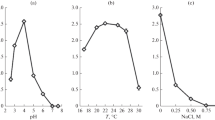Abstract
Effects of external ionic conditions ofD. discoideum cells were examined in relation to intracellular ionic concentrations, the activity of pyruvate kinase and the amount of ATP. Main components of metal cations in heat extracts of vegetative cells were K+, Na+, Mg2+ and Ca2+ whose concentrations in a cell were about 35.0, 3.6, 10.6 and 2.3 mM, respectively. External Na+ at the concentration more than 50 mM inhibited the formation of cell aggregates in the presence of 10−4M Ca2+. Such an inhibitory effect of Na+ was completely nullified by the addition of more than 10 mM K+. External Na+ caused a rapid decrease in intracellular K+, but an increase in intracellular Na+. Furthermore, it was found that the cells containing a high concentration of Na+ can develop normally in the presence of exogenous 10 mM K+, where intracellular K+ was maintaned at about 30 mM, irrespective of a high concentration of intracellular Na+ (about 30 mM). These suggest that the Na+-inhibition of the development is caused by a decrease in intracellular K+, but not by an increase in intracellular Na+. Pyruvate kinase extracted from the organism required K+ for its activation. The vegetative cells incubated in 50 mM Na+ contained only about 10 mM K+ which is insufficient for the enzyme activation. However, the amount of ATP in the cells containing less K+ was similar to that in those with much K+. These results are discussed in relation to the activity of glycolysis.
Similar content being viewed by others
Abbreviations
- EGTA:
-
ethyleneglycol bis (β-aminoethylether)-N,N,N′,N′-tetraacetic acid
References
Bonner, J.T. 1947. Evidence for the formation of cell aggregates by chemotaxis in the development of the slime mold,Dictyostelium discoideum. J. Exp. Zool.106: 1–26.
Bücher, T. andG. Pfleiderer. 1955. Pyruvate kinase from muscle. Methods in Enzymol.1: 435–440.
Danzuka, T. andK. Ueno. 1958. Metal ion buffer solution. Kagaku no Ryoiki12: 45–56 (in Japanese).
Evans, H.J. andG.J. Sorger. 1966. Role of mineral elements with emphasis on the univalent cations. Ann. Rev. Plant Physiol.17: 47–76.
Gregg, J.H. 1950. Oxygen utilization in relation to growth and morphogenesis of the slime moldDictyostelium discoideum. J. Exp. Zool.114: 173–196.
Maeda, Y. 1970. Influence of ionic conditions on cell differentiation and morphogenesis of the cellular slime moulds. Develop. Growth Differ.12: 217–227.
Marin, F.T. andF.G. Rothman. 1980. Regulation of development inDictyostelium discoideum. 4. Effects of ions on the rate of differentiation and cellular response to cyclic AMP. J. Cell Biol.87: 823–827.
Mason, J.W., H. Rasmussen andF. Dibella. 1971. 3′5′ AMP an Ca2+ in slime mold aggregation. Exp. Cell Res.67: 156–160.
Miyamoto, H., T. Ikehara, T. Sakai andH. Yamaguchi. 1976. Studies on simplified procedures for extraction and sensitive assay of adenine nucleotides in cultured mammalian cells. Acta Medica Kinki Univ.1: 75–85.
Unemoto, T. 1972. Role of cations and anions on the metabolic regulation. Protein, Nucleic Acid and Enzyme17: 353–369 (in Japanese).
White, G.J. andM. Sussman. 1961. Metabolism of major components during slime mold morphogenesis. Biochim. Biophys. Acta53: 285–293.
——and—. 1963. Polysaccharides involved in smile mold development 1. Watersoluble glycose polymer(s). Biochim. Biophys. Acta74: 173–178.
——and—. 1963. Polysaccharides involved in slime mold development 2. Watersoluble acid mucopolysaccharide(s). Biochim. Biophys. Acta74: 179–187.
Author information
Authors and Affiliations
Rights and permissions
About this article
Cite this article
Maeda, M. Alteration of cellular ionic constituents by external ionic conditions, and its significance in the development ofDictyostelium discoideum . Bot Mag Tokyo 96, 193–201 (1983). https://doi.org/10.1007/BF02499000
Received:
Issue Date:
DOI: https://doi.org/10.1007/BF02499000




